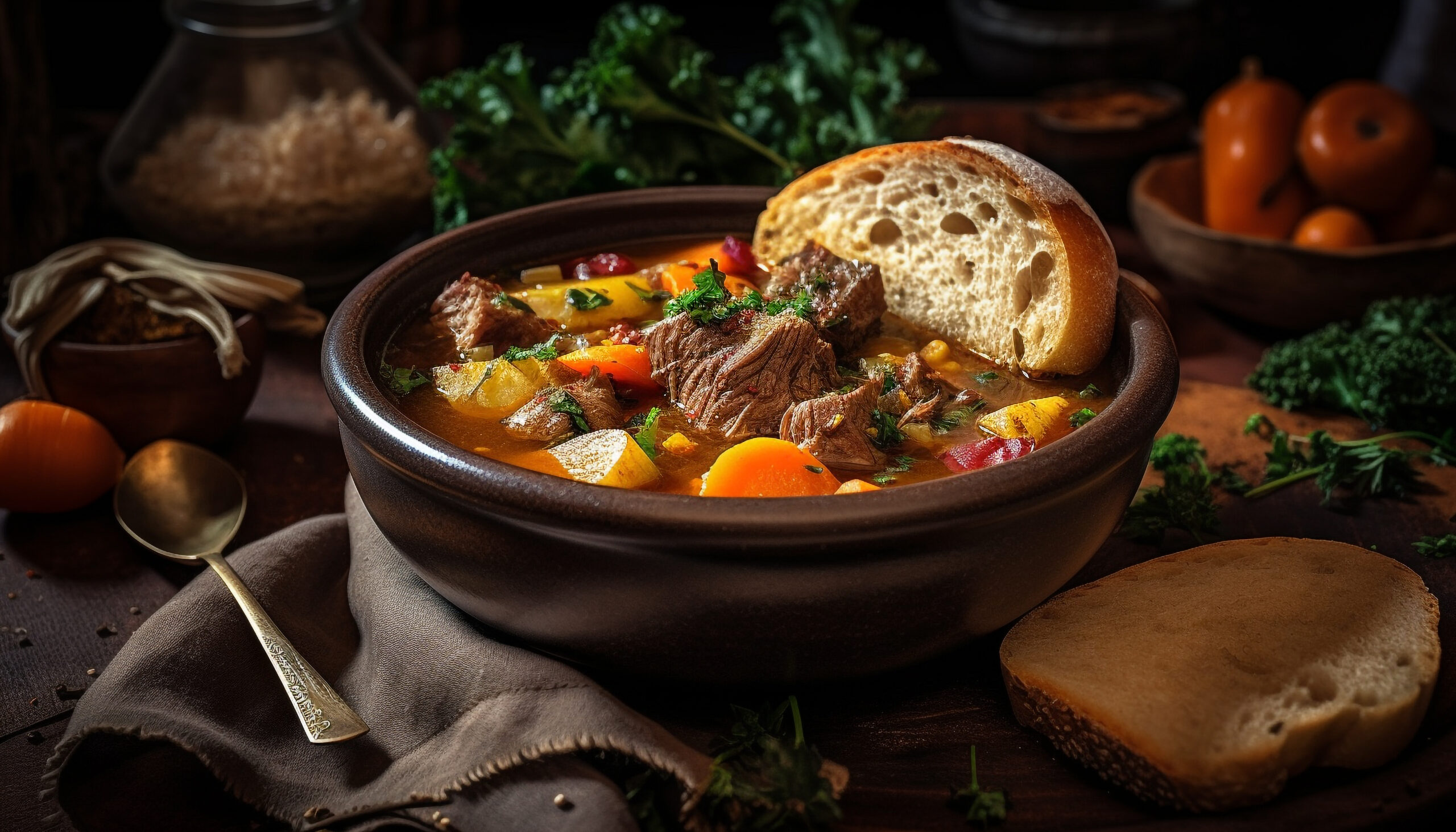Introduction
Discovering the Rustic Charm of Cowboy Soup
Imagine sitting around a crackling campfire under a starlit sky, the aroma of a simmering pot filling the air. This is the essence of Cowboy Soup, a dish steeped in the history and culture of the American West. It’s more than just a meal; it’s a symbol of resilience and resourcefulness, a hearty blend of ingredients that could be easily sourced or carried on long cattle drives. In this article, we’ll explore the origins, variations, and enduring popularity of Cowboy Soup, a dish that continues to bring warmth and satisfaction to tables around the world.
The Roots of Cowboy Soup
Tracing Back to the Open Range
The story of Cowboy Soup begins in the rugged landscapes of the American frontier. Cowboys, known for their hardy nature and simple living, needed meals that were not only filling but also easy to prepare with limited resources. They often had to make do with non-perishable ingredients that could withstand the rigors of the trail. Dried beans, preserved meats, and hardy vegetables formed the basis of their diet. Cowboy Soup emerged as a practical solution – a one-pot meal that could be cooked over an open fire, combining whatever ingredients were on hand.
A Dish Born from Necessity and Simplicity
The beauty of Cowboy Soup lies in its simplicity and adaptability. It’s said that no two pots of Cowboy Soup are ever the same, as the recipe varied depending on available ingredients. A typical Cowboy Soup might include beef or pork, beans, corn, tomatoes, onions, and a mix of spices. This not only provided essential nutrients but also offered a comforting and satisfying meal after a long day of hard work.
Essential Ingredients
The Building Blocks of Flavor
To make an authentic Cowboy Soup, one must understand the core ingredients that define its flavor profile. Let’s break down the key components:
- Meat: Beef, often in the form of stew meat or ground beef, is a common choice, providing a rich and hearty base. Pork or chicken can also be used as alternatives.
- Beans: Pinto beans are a staple in Cowboy Soup, but other varieties like black beans or kidney beans are also popular.
- Vegetables: Corn, tomatoes, onions, and potatoes are frequently used to add texture and nutrition.
- Broth: A beef or vegetable broth forms the liquid base, bringing all the ingredients together.
- Spices: Garlic, chili powder, cumin, and salt are typical seasonings that give the soup its distinctive flavor.
Customizing Your Soup
One of the joys of Cowboy Soup is its versatility. You can add or substitute ingredients based on personal preference or what you have in your pantry. For a spicier kick, add jalapeños or chili flakes. For more vegetables, throw in carrots, celery, or bell peppers.
Preparing Your Ingredients
Getting Ready for a Culinary Adventure
Before diving into the cooking process, it’s important to prepare your ingredients. This ensures a smooth cooking experience and helps develop the flavors more effectively.
- Meat Preparation: If you’re using beef or pork, consider browning the meat first. This step, although optional, adds depth to the flavor. Simply heat a little oil in a pan and cook the meat until it’s browned on all sides.
- Chopping Vegetables: Dice your onions, tomatoes, and any other vegetables you’re using into bite-sized pieces. This not only helps them cook evenly but also makes the soup easier to eat.
- Rinsing Beans: If you’re using canned beans, rinse them under cold water to remove excess sodium. For dried beans, remember they’ll need to be soaked overnight and cooked until tender before adding to the soup.
The Art of Seasoning
Seasoning is key in Cowboy Soup. Start with a base of salt, pepper, garlic, and cumin, then adjust according to taste. Remember, it’s easier to add more seasoning later than to fix an overly salty soup.
The Art of Cooking Cowboy Soup
A Step-by-Step Guide to Perfection
Now, let’s get to the heart of making Cowboy Soup. Here’s a simple guide:
- Start with the Base: In a large pot, sauté your onions and garlic until they’re soft and fragrant. This forms the flavor foundation of your soup.
- Add the Meat: If you haven’t browned your meat earlier, add it now and cook until it’s no longer pink.
- Combine Ingredients: Add your chopped vegetables, beans, and any additional ingredients like corn or potatoes. Stir everything together.
- Pour in the Broth: Add enough broth to cover the ingredients. Bring the soup to a boil, then reduce the heat and let it simmer.
- Let It Simmer: Allow the soup to simmer for at least an hour. This slow cooking process melds the flavors together beautifully.
- Final Seasoning: Taste your soup and adjust the seasoning as needed. Sometimes a splash of Worcestershire sauce or a pinch of sugar can balance the flavors.
Customizing Your Soup
Making Cowboy Soup Your Own
The beauty of Cowboy Soup is that it’s incredibly customizable. Here are some ideas:
- Vegetarian Version: Skip the meat and use vegetable broth. Add more beans and vegetables to make the soup hearty and filling.
- Spicy Twist: Add diced green chilies or a teaspoon of red chili flakes for a spicy kick.
- Creamy Variation: For a richer soup, add a splash of cream or a dollop of sour cream before serving.
The Nutritional Benefits
Good for the Body and Soul
Cowboy Soup isn’t just comforting; it’s also packed with nutrients. The meat provides protein, essential for muscle repair and growth. Beans are a great source of fiber and vitamins, while vegetables add a variety of nutrients and antioxidants. It’s a well-rounded meal that can be part of a balanced diet.
Serving Suggestions
How to Serve Cowboy Soup Like a Pro
Cowboy Soup is a versatile dish that can be served in various ways, depending on the occasion:
- As a Standalone Meal: Given its hearty nature, Cowboy Soup can be a complete meal on its own. Serve it hot, garnished with chopped fresh cilantro or parsley for a burst of color.
- With Bread: A slice of crusty bread or a warm cornbread muffin makes a perfect companion to this soup, ideal for soaking up the flavorful broth.
- Toppings: Offer a range of toppings like shredded cheese, sour cream, diced avocados, or crispy tortilla strips to let everyone customize their bowl.
Pairing with Beverages
When it comes to pairing beverages with Cowboy Soup, you have several options:
- Red Wine: A glass of bold red wine, such as a Zinfandel or Syrah, complements the rich flavors of the soup.
- Beer: A cold beer, especially an ale or lager, pairs well with the hearty and spicy nature of the soup.
- Iced Tea: For a non-alcoholic option, iced tea with a slice of lemon offers a refreshing contrast to the soup’s richness.
Storing and Reheating
Keeping Your Soup Delicious for Days
Cowboy Soup is a great make-ahead meal, as it stores and reheats well:
- Refrigeration: Store the soup in an airtight container in the refrigerator for up to 3-4 days.
- Freezing: For longer storage, freeze the soup in portion-sized containers. It can last up to 3 months in the freezer.
- Reheating: When ready to eat, reheat the soup on the stove over medium heat until it’s hot throughout. If it’s too thick, add a little water or broth to thin it out.
Cowboy Soup Across Cultures
A Global Twist on a Western Classic
While Cowboy Soup has its roots in the American West, its basic concept – a hearty, one-pot meal – is universal. Variations of the soup can be found in different cultures:
- Mexican Influence: In Mexico, a similar dish known as “Caldo de Res” includes beef, vegetables, and a rich, spicy broth.
- European Adaptations: In Eastern Europe, hearty stews with meat, beans, and vegetables are common, echoing the spirit of Cowboy Soup.
Vegetarian and Vegan Variations
Inclusive Cooking for All
Cowboy Soup can easily be adapted for vegetarian or vegan diets:
- Meat Substitutes: Use plant-based meat alternatives or increase the quantity of beans for added protein.
- Vegetable Broth: Replace the beef or chicken broth with a rich vegetable broth to maintain the soup’s robust flavor.
Kids and Cowboy Soup
Making It Kid-Friendly
It can be a hit with kids, thanks to its simple flavors and customizable nature. To make it more appealing to younger palates:
- Mild Flavors: Keep the spices mild and avoid overly hot ingredients.
- Fun Toppings: Let kids choose their toppings, such as grated cheese or crackers, to make the meal more interactive and enjoyable.
Cowboy Soup Through the Seasons
A Year-Round Comfort Food
Cowboy Soup is not just a winter dish; it can be adapted for any season:
- Summer Version: Add fresh tomatoes and corn for a lighter, summery version.
- Autumn Twist: Incorporate seasonal vegetables like squash or pumpkin for a fall variation.
Conclusion
Celebrating the Timeless Appeal of Cowboy Soup
This Soup is more than just a dish; it’s a celebration of simplicity, versatility, and heartiness. Whether you’re cooking for a crowd, a family dinner, or a cozy meal for one, this soup is sure to satisfy. Its ability to be adapted and personalized makes it a beloved recipe that stands the test of time. So, grab your pot and ingredients, and let the comforting journey of making Cowboy Soup begin!
FAQs
- Can Cowboy Soup be made in a pressure cooker or Instant Pot?
- Yes, it can be easily adapted for a pressure cooker or Instant Pot, significantly reducing the cooking time while retaining the flavors.
- What are some common spices used in Cowboy Soup?
- Typical spices include cumin, chili powder, garlic powder, and paprika, but you can adjust these to suit your taste preferences.
- How can I thicken Cowboy Soup if it’s too watery?
- To thicken the soup, you can simmer it uncovered to reduce the liquid, add a cornstarch slurry, or mash some of the beans and vegetables.
- Is Cowboy Soup gluten-free?
- it can be gluten-free if you ensure that all ingredients, including the broth and any added thickeners, are free of gluten.
- What makes Cowboy Soup different from other beef and vegetable soups?
- it is characterized by its hearty ingredients, rich and spicy broth, and the flexibility to include a variety of meats and vegetables, making it a unique and customizable dish.

